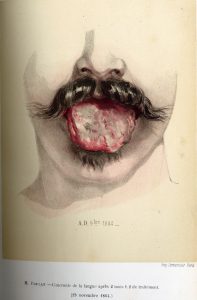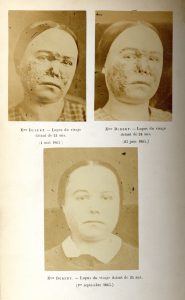Le texte ci-dessous rédigé par le Pr Gerd Plewig (Münich) a pour objet de faire connaître Gilbert Déclat de Nebout, pionnier de l’asepsie par l’acide phénique avant les travaux de Lister et précurseur en matière de photographie médicale. Il publia notamment des clichés d’un malade atteint de lupus – dont on remarquera qu’il donne le nom – en 1865, soit trois ans avant les photographies publiées par Montméja et Hardy dans la Clinique photographique de l’hôpital Saint-Louis. On peut trouver des exemplaires dans diverses bibliothèques, notamment à la BIU Santé Pharmacie (cote : 21696.)
A lire : https://www.biusante.parisdescartes.fr/sfhm/hsm/HSMx1982x016x002/HSMx1982x016x002x0115.pdf
Nouvelles applications de l´acide phénique en médecine et en chirurgie aux affections occasionnées par les microphytes, – les microzoaires, -les virus, les ferments, etc., gangrène, – cancroïdes, maladies graves de la peau, fièvres typhoïdes, choléra, rage, etc., par le Docteur G. Déclat. (fig 1)
Ouvrage orné de cinq photographies. Delahaye, Paris, Hippolyte Baillière, Londres, C. Bailly-Baillière, Madrid, Octobre 1865. XVIII, 19-208 p, ouvrage orné de cinq photographies, Contemporary maroon leather, front, back and spine gilt, First edition.(fig 2) ,

Plate I following p XVI Cancroide de la lèvre supérieure opéré deux fois (16 janvier 1865.) (figs 3, 4)

Plates II & III: The chromolithographed plates following p 56 A.D. 15 septembre 1864. M. Poulat. – Cancroide de la langue datant de 4 ans. (15 septembre 1864 & A.D. 23 novembre 1864. M. Poulat – (fig 5) Cancroide de la langue après 2 mois ½ de traitement. (23 novembre1864.). Imp. Lemercier Paris. (fig 6)


Plate IV following p 76 with 1 mounted original photo M. Poulat. – Cancroide guéri de la langue. – Profondes cicatrices. (25 juillet 1865.) (fig 7)

Plate M***, Cancroide ulcéré de la langue datant de 8 ans, 13 janvier 1865. M***, Cancroide guéri de la langue, profondes cicatrices, 20 septembre 1865. (figs 8,9)

Plate V following p 96 with 3 mounted original photos Mme Dubert. Lupus du visage datant de 24 ans. (4 mai 1865) & Mme Dubert. – Lupus du visage datant de 24 ans. (23 juin 1865.) & Mme Dubert. – Lupus du visage datant de 24 ans. (1er septembre 1865.) (fig10, 11,12)

The above work is rare, illustrated with 8 original photographs in albumen print and two chromolithographs of this absolutely pioneering text in the history of asepsis before Lister.
Based on Pasteur´s germ theory, Déclat used an active agent, here phenol, to treat infected wounds in cases of cancroids, illustrated by 5 photographs, but also of facial lupus, illustrated with 3 photographs. In additon, Déclat also had the idea of applying carbolic acid to internal pathologies such as cancer, disease of the uterus, etc.
A landmark text both in its use of original photography for the publication of a book on surgery and practical medicine and in the revolutionary history of asepsis. It preceded the other monumental work illustrated with photographs of Hardy and Montméja 1868.
It was in 1860 that phenic acid was proposed by Lemaire in the treatment of wounds. It was then recommended by Déclat, adopted by Maisonneuve, Demarquay, A. Richard and others. Its use, which had only been restricted, did not become general until after the publication s of Lister and … by J.-L. Champonnière, Aubert, Poinsot, Panas. etc.
Gilbert Déclat de Neboud was an insistent and prolific crusader for greater acceptance of carbolic acid as an antiseptic in the maternity wards and for the treatment of diseases, including typhoid, and as the enemata for a host of wounds and lesions almost without exception. Carbolic acid was already known to cure cancer sores, but he was the first to recognize its antimicrobial potency, predating Lister´s advocacy by nearly a decade and Pasteur´s by two years. In fact, James Simpson had read Déclat´s monograph and denounced Lister, a former student, for plagiarism. Gaillard´s Medical Journal 32: 342
Déclat´s first public demonstration took place at Maison Frères Saint-Jean-de Dieu in Paris on November 30, 1861, for which he used his phenol compound to treat a case of intractable gangrene. Witnessing the demonstration were Drs. Grosand the surgeon Jules Germain François Maisonneuve (1809-1897). At the time, it was thought that hospital infections came from poisonous compounds generated in wounds that were exposed to air, and Maisonneuve had devised an elaborate vacuum apparatus to maintain aspiration continually under the surgical dressings of his patients. Impressed by Déclat´s demonstration, Maisonneuve introduced carbolic acid into his practice at Hôtel-Dieu.
The above is extremely rare. Karlsruher Virtueller Katalog lists one copy in The British Library, St. Pancras, London, and a second edition 1872 (or 1773 ?) in the same library.
Catalogue of The Library of the Royal Medical and Chirurgical Society of London vol I, 314
Waring/Bibliotheca therapeutic 312 (first edition 1865), 313 (second edition 1873).
On line on Gallica https://gallica.bnf.fr/ark:/12148/btv1b8625649z/f7.item
Gerd Plewig, München, March 2021
